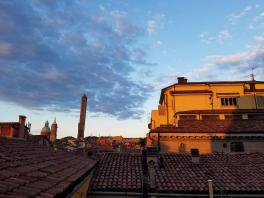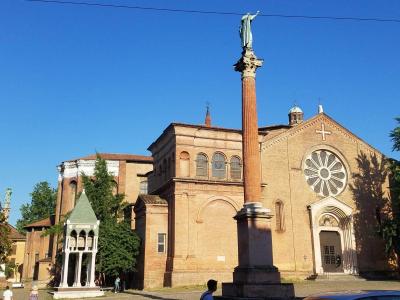
When Audrey Hoffmann, a lecturer in French, arrived at Ohio State, she had plenty of experience as a study abroad guide in Paris, France and a lot of love for the city. Before long, she was off to Paris with 24 OSU students for the first round of the Global May Paris study abroad program. Jonathan Combs-Schilling, Assistant Professor in Italian, who had spent a life-changing year in Bologna, Italy as a student, will be taking his first group of students to the Bologna as part of the Italian City Program next May. Both the Global May Paris and the Italian City Program satisfy a GE requirement, and cater towards students who might have never traveled before.
The main focus of the Global May Paris program is a cultural one. By offering just two weeks abroad with no need to speak French, Hoffmann hoped to make this trip possible to freshmen who had no experience with travelling. She wanted students to become mindful of other cultures, and to explore what it means to travel by themselves or as a group, and how they feel in a different country with a new language and culture. Through a series of cultural visits and exercises, the program encouraged cultural and personal growth. “Paris is fantastic for thought,” Hoffmann says, “there is so much to do and to see, it is so interesting.”

The program was a success beyond what Hoffmann could have imagined. The students were very present, very engaged, and they wanted to make the most out of the trip. “The spirit among the group was absolutely fantastic,” she says. They were lucky with the weather and the guides they had at various sites, which made the experience even better.

The program highlighted some of the well-known sites in Paris, like the Notre Dame, Eiffel Tower, and Montmartre, but Hoffmann also wanted to include some less touristy visits. One of the places they explored was a suburb south of Paris called La Vallee-aux-Loups, which had been the residence of romantic writer Chateaubriand. There, in the shade of rare trees in the beautiful garden, on a sunny day, the group relaxed in the grass and shared personal stories. To Hoffmann this was one of the best parts of the trip.
The program will continue to run annually. Though Hoffmann will not be teaching it next year, she is excited to pass it on. She saw that students went back again and again to sites they had visited on their own or with small groups. They had built new connections amongst each other and with a new city and culture. “It was amazing to bring this program to people who had never travelled before,” says Hoffmann.
Combs-Schilling created the Italian City Program with a similar mindset. “Bologna is great for a first experience abroad,” he says, “It is holds visible traces of 1000 years of history, but is also modern, it is bustling and culturally rich, but at the same time small enough to feel like a home.” Students who have some familiarity with Italy and students who have never experienced a course in humanities alike will have an amazing time exploring Bologna and learn the skills necessary to explore other cultures later in their life.
The program will span four weeks. No prerequisites are required and everything will be conducted in English. Minors and majors of Italian are encouraged by participate as well, but no knowledge of the language or culture is necessary to excel. The main theme of the program will be the concept of the city, which will be explored through readings on historical events, short stories, plays, movies, and other mediums. To allow students to explore differences and similarities of cities, three case studies will be conducted as day trips to Ferrara, Milan, and Florence, but the rest of the course will take place in Bologna itself.
Bologna is the crossroads of Italy, located in the middle of North and South, past and present. Due to its geographical and cultural location, it holds a variety of museums like no other city. There are museums for any thematic interest – medieval museums, museum on the history of students, international music museum. “You can view a painting that Mozart had done of himself and sent to a friend in Bologna,” explains Combs-Schilling. Bologna has the oldest university in Europe, which saw students like Copernicus and Michelangelo. It also has incredible food, and many of America’s favorite Italian foods have origins in Bologna.
When he lived in Bologna, Combs-Schilling often visited a small chapel, called Oratorio di Santa Cecilia. It is a little-known Renaissance chapel, built privately for a famous Bologna family, and completed right around the time that this family was expelled from the city. The chapel is quiet and serene. Right next to it is a square where local students frequently get together to have a good time. “The juxtaposition of these two spots, right next to each other, shows how Bologna, and other cities, are filled with magical contrasts,” says Combs-Schilling. Such contrasts, and countless other new ways of exploring and understanding a city await students in Bologna during the Italian City Program.
The deadline to apply to Global May Paris and The Italian City programs for 2019 is January 3rd.
